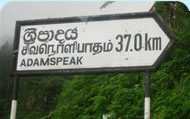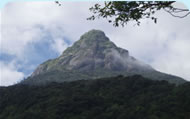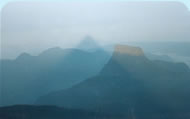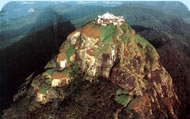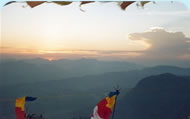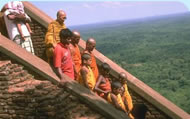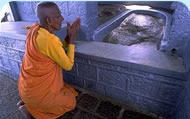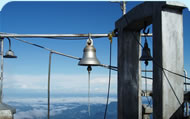|
Sri Pada: Sanctuary for all Faiths
by S.S.M. Nanayakkara
The sanctification of Sri Pada as a tryst of homage by the four dominant faiths in Sri Lanka - Buddhist, Hindu, Islam and Christian - is steeped in mystery, myth, legend, and also oral and chronicled history.
Unlike the Haram Ash Shariff - Jerusalem's hallowed temple mount one of the world's most fiercely contested pieces of real estate where Christians, Moslems and Jews have slaughtered one another for centuries, Sri Pada provides a refuge for the followers of all faiths. It holds a unique place in the country's cultural heritage. The Ramayana - immortal epic of the Sanskrit poet and sage Valmiki (C. 300 BC) makes mention of it, and Alexander the Great, Macedonian warrior king and empire builder (356-323 BC) is reputed to have visited it in 330 BC after his successful campaign in India.
The great dynastic chronicle of Sri Lanka (Mahawamsa), contains the earliest authenticated records of the peak having being dedicated to Gautama Buddha and the Hindu deity Saman. It records that King Dutugemunu being at the point of death at Anuradhapura in 140 BC called for the thero Pullabaya, one of his quondam military aides to invoke his blessings. The venerable monk, attended by a retinue of three hundred disciples, hurried to the bedside of the dying king. He consoled the king recounting several of his meritorious deeds, adding that these alone would suffice for him to attain salvation. The king being deeply moved by the absolution, rejoined that of all the good deeds enumerated by the thero one that comforted him the most was the allusion to his donation of conjee to five eminent monks during an unprecedented famine in the land. Maliyadeva one of the monks to whom the donation was offered, divided it among the fraternity then resident at the sacred mount of Saman. This passage in the Mahawamsa (chapter 32) indicates that the peak was held sacred prior to 140BC.
 |
A later tradition attributes the location of the sacred foot print on the summit of the mount to king Valagambahu, who ascended the throne in 104 BC. After a brief reign of five months he was ousted by Chola invaders from South India - that part of the country now known as Tamil Nadu. For 14 years he languished as a fugitive hiding and biding his time among the mountain fastnesses in the central regions. For a part of the period he took refuge in a cave known as Bagawanlena (Buddha's cave) on Samankuti by which name Sri Pada was then known. One day a deer wandered to this mountain grotto. The king gave chase to the fleeing quarry up to the top of the peak where the latter vanished in an ephemeral halo of luminescence. On reaching the spot where the deer mysteriously vanished, the king discovered the foot print. After his restoration to the throne, Valagambahu caused the foot print to be enclosed by large iron spikes. The enclosure formed the first foundation for the terraced platform providing access to the sacred foot print.
Fa Hien, the noted Chinese pilgrim traveller who visited Anuradhapura in 413 AD records in his chronicles: "By strength of his divine powers He (the Buddha) left the print of one of his feet on the summit of a soaring mountain in this blessed land." Fa Hien's visit took place during the reign of King Mahanama. Ibn Batuta, the romantic Arab traveller from Tangier came to the island on a visit to Sri Pada in the 14th century. He refers to a grotto at the foot of the peak with the word 'Iskander' carved on it. This 'Iskander' referred to, is popularly believed to be King Alexander the Great. If tradition is to be credited, Alexander the Great is reputed to have visited the peak after his successful campaign in India in 330 BC. The iron chains and stanchions rabetted on to the rock face of the peak are attributed to him. "The ancients" says Batuta "have cut steps of a sort on the steep rock face, to these steps are fixed iron stanchions with suspended chains to enable pilgrims to hoist themselves up with minimum risk. The impression of the Almighty's foot is observed upon a black and lofty rock in an open space on the summit."
Robert Knox, the celebrated English captive of King Rajasinghe II of Kandy (1635-1685) records with au courant insight on the contemporary state of the interior of the country, the ways, customs, religious beliefs and language of its inhabitants. Posterity is indebted to this astute observer for his revealing records in the book 'Historical relation of the island of Ceylon' which he published on his dramatic escape to England. Referring to Sri Pada Knox notes: "The main river of all is Mawelgong (Mahaweli ganga) which proceeds out of the mountain called Adam's Peak. On the south side of Conde Uda (Kandy) is a hill supposed to be the highest in this land called in the Chingulay language (Singhalese) smallel (Samanela) but by the Portuguese and Europeans, Adam's peak. To this peak, the highest in the land where there is the Bouddou's foot print (Buddha's) which he left on the top of the mountain, they go with their wives and children."
John Maundeville, a 14th century traveller to the island, gives a grotesque description of the peak. In his chronicles he notes: "In that isle is a great mountain and in the midst of this is a full fair plain. They of the country say that Adam and Eve wept upon the mount when they were driven out of Paradise. They shed so much tears that a lake was formed at the bottom." There is a strong probability that the mountain was dubbed 'Adam's Peak' by European after Maundeville.
In 1805, Captain Robert Percival who served with the British garrison in Colombo notes: "The iron chains on the rock face of Adam's Peak have the appearance of being planted there at a very distant period. Who placed them there or for what purpose they were set up there it is difficult for any one to know - the beliefs and superstitions of the natives present difficulties. whatever it is, all evidence indicate that the peak was in the limelight long before the recorded history of the island."
Courtesy The Sunday Observer of 27 August, 2000
